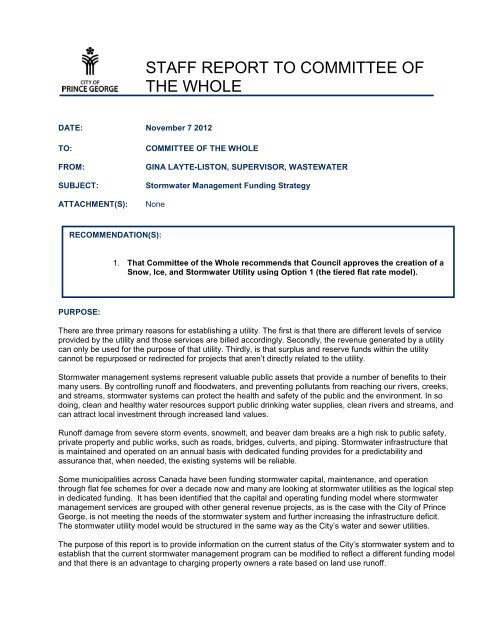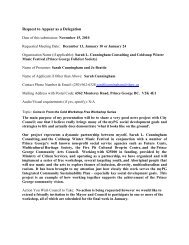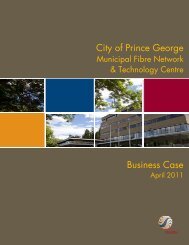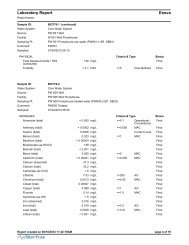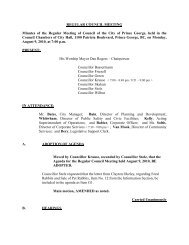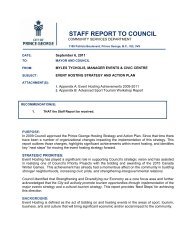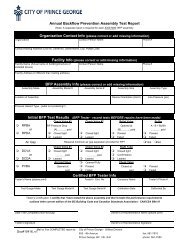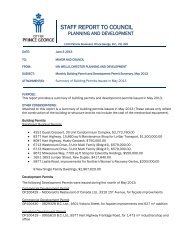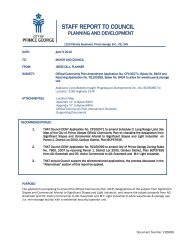Stormwater Management Funding Strategy - City of Prince George
Stormwater Management Funding Strategy - City of Prince George
Stormwater Management Funding Strategy - City of Prince George
You also want an ePaper? Increase the reach of your titles
YUMPU automatically turns print PDFs into web optimized ePapers that Google loves.
STAFF REPORT TO COMMITTEE OFTHE WHOLEDATE: November 7 2012TO:FROM:SUBJECT:ATTACHMENT(S):COMMITTEE OF THE WHOLEGINA LAYTE-LISTON, SUPERVISOR, WASTEWATER<strong>Stormwater</strong> <strong>Management</strong> <strong>Funding</strong> <strong>Strategy</strong>NoneRECOMMENDATION(S):1. That Committee <strong>of</strong> the Whole recommends that Council approves the creation <strong>of</strong> aSnow, Ice, and <strong>Stormwater</strong> Utility using Option 1 (the tiered flat rate model).PURPOSE:There are three primary reasons for establishing a utility. The first is that there are different levels <strong>of</strong> serviceprovided by the utility and those services are billed accordingly. Secondly, the revenue generated by a utilitycan only be used for the purpose <strong>of</strong> that utility. Thirdly, is that surplus and reserve funds within the utilitycannot be repurposed or redirected for projects that aren’t directly related to the utility.<strong>Stormwater</strong> management systems represent valuable public assets that provide a number <strong>of</strong> benefits to theirmany users. By controlling run<strong>of</strong>f and floodwaters, and preventing pollutants from reaching our rivers, creeks,and streams, stormwater systems can protect the health and safety <strong>of</strong> the public and the environment. In sodoing, clean and healthy water resources support public drinking water supplies, clean rivers and streams, andcan attract local investment through increased land values.Run<strong>of</strong>f damage from severe storm events, snowmelt, and beaver dam breaks are a high risk to public safety,private property and public works, such as roads, bridges, culverts, and piping. <strong>Stormwater</strong> infrastructure thatis maintained and operated on an annual basis with dedicated funding provides for a predictability andassurance that, when needed, the existing systems will be reliable.Some municipalities across Canada have been funding stormwater capital, maintenance, and operationthrough flat fee schemes for over a decade now and many are looking at stormwater utilities as the logical stepin dedicated funding. It has been identified that the capital and operating funding model where stormwatermanagement services are grouped with other general revenue projects, as is the case with the <strong>City</strong> <strong>of</strong> <strong>Prince</strong><strong>George</strong>, is not meeting the needs <strong>of</strong> the stormwater system and further increasing the infrastructure deficit.The stormwater utility model would be structured in the same way as the <strong>City</strong>’s water and sewer utilities.The purpose <strong>of</strong> this report is to provide information on the current status <strong>of</strong> the <strong>City</strong>’s stormwater system and toestablish that the current stormwater management program can be modified to reflect a different funding modeland that there is an advantage to charging property owners a rate based on land use run<strong>of</strong>f.
245487POLICY / REGULATORY ANALYSIS:Storm Sewer Bylaw No. 2656 (1974) and the Comprehensive Fees and Charges Bylaw No. 7557 (2004) willrequire updating.The Official Community Plan Bylaw No. 8383, 2011, approved by Council in April 2012 states under Policy13.2.14 that the <strong>City</strong> should review its Storm Sewer Bylaw and consider a stormwater utility to fund theongoing operating and maintenance <strong>of</strong> its stormwater network.OTHER CONSIDERATIONS:The <strong>City</strong> maintains approximately 373 kilometres <strong>of</strong> conveyance systems and associated service connections,1088 kilometres <strong>of</strong> ditches, 12,497 culverts, 5075 catchbasins, 3568 manholes, 8 stormwater managementponds, and 110 outfalls. The total value asset <strong>of</strong> the storm system is in the range <strong>of</strong> $171 million. The currentannual operating and capital budgets <strong>of</strong> these assets is approximately $4.1M, which is 2% <strong>of</strong> the total assetvalue. The <strong>City</strong> <strong>of</strong> <strong>Prince</strong> <strong>George</strong>’s current stormwater program consists <strong>of</strong> three general components:operating and maintenance, capital projects, and emergency work. Other communities also haveenvironmental compliance, planning, and management as additional components.The following table is provided for the Committee’s information:Storm Drainage2005 2006 2007 2008 2009 2010 2011Capital Spending 456,499 348,144 378,747 986,255 291,432 851,106 123,813RIVA/AssetRequired investment: $1,590,000 per year<strong>Management</strong>The <strong>City</strong> is responsible for managing all aspects <strong>of</strong> stormwater. However, the <strong>City</strong>’s ability to effectively andadequately perform its duties is limited by available funding. Factors that are impacting the stormwater systeminclude:• Urbanization: Growth and development alters the amount <strong>of</strong> run<strong>of</strong>f and pollution discharged intothe system;• Aging infrastructure: Pipes, culverts and outfalls have a limited life expectancy and must berepaired and replaced;• Design standards: Regulatory requirements are always changing such that systems designed toprevious criteria may be inadequate with respect to current standards;• Maintenance: Problems result if we are not actively operating facilities, maintaining watercourses,and sweeping streets (collecting leaves and debris);• Design and construction: Development site plans must be properly reviewed and adequatelyinspected during construction to minimize the potential for hazards; and,• Intensity and frequency <strong>of</strong> rainfall events as a result <strong>of</strong> climate change.Many <strong>of</strong> the best management practices (BMPs) that have been constructed within the <strong>City</strong> (e.g. Storm ponds,oil/grit separators, etc.), are not only designed to prevent against flooding and erosion, but improve waterquality for aquatic and terrestrial habitat as well as downstream drinking water recipients. All <strong>of</strong> the stormwaterflow within the <strong>City</strong> <strong>of</strong> <strong>Prince</strong> <strong>George</strong> is directed towards the Nechako and Fraser Rivers. <strong>Stormwater</strong> relatedworks are subject to legislation such as the British Columbia Water Act, Canadian Environmental ProtectionAct, the Fisheries Act and several guidelines published through the BC Ministry <strong>of</strong> Environment.The <strong>City</strong> currently funds its stormwater improvements, both operating and capital from general revenuecollected, through property taxes based on assessed value. Where new infrastructure is required for newdevelopment, development cost charges may be used to fund specific stormwater collection infrastructure.
245487With competing demands for general revenue, there is value in considering alternative ways to support thestorm water system by providing sustainable funding that is fair, equitable, and flexible. There are variousfunding mechanisms that can be used to support the stormwater infrastructure maintenance andimprovements. Canadian municipalities have adopted flat rate user fees, tiered rate user fees, or stormwaterrates based on impervious surfaces or zoning and intensity <strong>of</strong> development. In most cases, the costs <strong>of</strong> stormwater management have been removed from the general tax levy once the stormwater utility has beenapproved and becomes revenue neutral- a tax shift.STORMWATER MANAGEMENT FUNDING – BEST PRACTICESMost Canadian municipalities still rely on funding the operation, maintenance and capital improvements <strong>of</strong> theirstorm water facilities through property taxes based on assessed value. With the growth in complexity <strong>of</strong>stormwater management issues comes the requirement for adequate and predictable funding to ensureoptimal solutions. As these stormwater issues, which include environmental protection, become moreprevalent, cities are increasingly looking at innovative ways to fund the management <strong>of</strong> stormwater programs.The Canadian municipalities listed in this report have initiated a variety <strong>of</strong> service charges, fees, levies orparcel taxes in order to secure dedicated funding to address stormwater funding deficiencies. This method isconsidered to be a far more equitable approach than funding stormwater through general revenue which isbased on assessed property value.The “user pay” or impervious surface calculation (Option 2) method is considered to be a most equitablemanagement practice. Of the communities researched for this report, only Edmonton and Kitchener-Waterloohave adopted this practice (Victoria is in the final stages). In most cases, it is noted by the other municipalitiesthat the cost and complexity <strong>of</strong> a stormwater user rate prohibited its execution at the onset but is considered tobe an endpoint for many.For <strong>Prince</strong> <strong>George</strong>, the addition <strong>of</strong> snow management within the concept <strong>of</strong> a stormwater utility is a uniqueconsideration, one not applied at the other communities researched by <strong>City</strong> staff. The idea <strong>of</strong> including snowmanagement in the stormwater utility rate is supportable as snow melt run<strong>of</strong>f impacts <strong>City</strong> storm sewerinfrastructure, ditches and snow disposal sites. During the spring, when the snow is melting, whether it is piledhigh on a corner or melting <strong>of</strong>f <strong>of</strong> a property, the stormwater system is used as if it is rainwater. The systemmust be able to move that snowmelt and any other precipitation through the pipes and discharge it to thecreeks, rivers, and streams around the <strong>City</strong>. Both quantity and quality are factors for consideration.In the case <strong>of</strong> snow management levy, all property owners benefit from snow removal. Applying a rate that isdetermined by considering level <strong>of</strong> service within various <strong>City</strong> sectors and property frontage could beconsidered to be more equitable.The following are examples <strong>of</strong> municipalities that have achieved, or are working towards, dedicated funding forstorm water management issues:<strong>City</strong> <strong>of</strong> Regina<strong>City</strong> <strong>of</strong> EdmontonFlat fee, property size - The fee for drainage is a daily fee applied to the total propertysize in increments <strong>of</strong> 2,000 m 2 . For example: 1,001 to 3,000m 2 = $0.58 per day, 3,001to 5,000m2 = $1.16 per day, 5,001 to 7,000m 2 = $1.74 per day etc.Impervious surface area, development intensity factor - Edmonton has a fully fundedstormwater utility with all <strong>of</strong> the fees based on total impervious surfaces.Considerations in the calculation <strong>of</strong> rates include:1. Area <strong>of</strong> property - lot size in square metres (m 2 ).2. Development Intensity - the measure <strong>of</strong> the portion <strong>of</strong> lot being utilized for itsintended development.For residential customers the intensity <strong>of</strong> development factor is 1.For non-residential properties that are largely undeveloped or utilizing on-sitestormwater management, a reduced factor may apply.
245487Strathcona County<strong>City</strong> <strong>of</strong> Calgary<strong>City</strong> <strong>of</strong> Hamilton<strong>City</strong> <strong>of</strong> London, ONKitchener-Waterloo<strong>City</strong> <strong>of</strong> Langley<strong>City</strong> <strong>of</strong> Surrey<strong>City</strong> <strong>of</strong> Pitt Meadows<strong>City</strong> <strong>of</strong> VictoriaProperties draining directly to the North Saskatchewan River are eligible for acredit to reduce their stormwater fee.3. Run-<strong>of</strong>f coefficient - the permeability <strong>of</strong> your lot's surface (i.e. grass versusconcrete), based on land zoning.The run-<strong>of</strong>f coefficient for a single detached residential property is typically0.5-0.65.4. Rate - the rate used for the base calculation (approved by <strong>City</strong> Council) and appliesto all properties.Flat fee - This Alberta County has established a flat fee for drainage which is attachedto the customer’s sanitary sewer utility bill.Flat fee - Calgary has a flat fee “drainage service charge” to all their sanitary sewercustomers which is intended to provide dedicated funding for capital projects.Flat fee – in 2004, Hamilton established a flat fee for stormwater which is attached tothe customer’s water/sanitary sewer utility bill.Flat fee- in 2004, London established a Storm Drainage Charge which is a flat ratecharge for residential, commercial and institutional customers and is charged on aland area basis for industrial customersImpervious surface area, development intensity factor - The twin cities <strong>of</strong> Kitchenerand Waterloo adopted a stormwater utility in June 2010. The stormwater user rate feeis charged on the basis <strong>of</strong> stormwater run<strong>of</strong>f contribution to the <strong>City</strong>'s stormwatermanagement system. Under the new method, land use classification, property size,estimated impervious area and the intensity <strong>of</strong> infrastructure is the basis to estimatethe level <strong>of</strong> contribution <strong>of</strong> stormwater in the <strong>City</strong>'s stormwater management system.Flat rate (residential) - Langley has a stormwater levy as a line item added to theirresidential tax bill. This tax is intended to be dedicated funding to cover themunicipalities stormwater operating expenditures.Flat rate by parcel - Surrey has developed a dedicated drainage parcel tax.Two-tiered flat rate (residential), flat rate and property area (rural, commercial) - PittMeadows funds the drainage utility in two ways- a utility charge based on assessedvalue; and a levy, which is a flat rate for residential properties or a charge per area forrural and commercial properties.Impervious surface area - Similar to Edmonton, Victoria’s stormwater utility will bebased on a total impervious surface area model. This fee will begin to be charged inJanuary 2013.In discussions with a number <strong>of</strong> municipalities, especially those in Ontario, it was noted that they have beenusing a flat rate fee structure for a number <strong>of</strong> years and are now moving towards a user rate based onimpermeable surface area similar to Option 2. In Hamilton, Council did not approve the new user ratestructure (Option 2) because <strong>of</strong> the cost to implement.Based on research from other communities in Canada, the <strong>City</strong> <strong>of</strong> <strong>Prince</strong> <strong>George</strong> may consider the fundingmodels: Tiered Flat Rate Model or <strong>Stormwater</strong> User Rate Model.
245487OPTION 1: Tiered Flat Rate <strong>Funding</strong> ModelThe Tiered Flat Rate funding model apportions a flat rate charge to a property based on the property’s landuse or zoning classification. The rationale for assigning stormwater charges based on land use is that there isgenerally a correlation between zone type and the higher volume <strong>of</strong> run<strong>of</strong>f due to hard surfaces, such as ro<strong>of</strong>s,parking areas, and sidewalks. This generalization is an accepted engineering practice for stormwatermanagement planning and designs and, as such, is applicable.In factoring in the snow and ice portion <strong>of</strong> the utility, we would be considering what level <strong>of</strong> service is beingprovided to each sector within the <strong>City</strong>.There would be up-front implementation costs for populating the existing Utilities billing system. <strong>City</strong> staff hasdetermined that the most efficient approach to populating the new utility accounts would be to use the existingwater meter accounts for multi-family, industrial, commercial and institutional customers. Exceptions wouldinclude properties outside <strong>of</strong> the <strong>City</strong>’s water service area <strong>of</strong> which there are approximately 2000 accounts.With the use <strong>of</strong> the <strong>City</strong>’s GIS system the size <strong>of</strong> the property would be determined and a rate assigned. Thesingle family residential accounts would be charged a flat fee determined by the properties’ zoning. Onceimplemented, there would be on-going administrative support (customer service) and billing updates for theprogram which would equate to at least one additional staff person.To provide better refinement to the Tiered Flat Rate calculations, it is possible to include a value in thecalculation that takes into consideration the percentage <strong>of</strong> run<strong>of</strong>f contribution from a property. A larger valuewill have lower infiltration and higher run<strong>of</strong>f (pavement, steep gradient), and a lower value will be morepermeable with more vegetated areas (forest, grass). For example, a property that has a large commercialbuilding, sidewalks, and a parking lot will have a much higher run<strong>of</strong>f than a single family home with a smalldriveway and grass lawn. As well, for each property classification, additional tiers could be identified based onproperty size.Below is an example <strong>of</strong> Option 1: a comparison between general tax revenue apportioned for various land usetypes and the 2012 budget for stormwater, snow, and ice management. It is important to note that thenumbers presented below are high level and based on preliminary calculations.Current <strong>Stormwater</strong> & Snow paid by Property TaxTiered Flat Rate- Snow, Ice, and <strong>Stormwater</strong> UtilityParcel Type% <strong>of</strong>TotalTax<strong>Stormwater</strong>SnowCombined TaxLevyAccounts% Run<strong>of</strong>fFactor% <strong>of</strong> TotalUtility *RevenueContribution byLand UseResidential 54 2,206,000 2,722,000 4,928,000 27,431 40-70 40 $3,665,000Commercial 27 1,103,000 1,361,000 2,464,000 2,004 80-90 34 $3,085,000Industrial 19 776,000 956,000 1,732,000 141 30-90 25 $2,287,000Farm 0.05 2,000 2,000 4,000 400 5-20 1 $91,000Tax Exempt 0.0 0 0 0 1,370 60-80 0 $0 **TOTAL 100 $4,087,000 $5,041,000 $9,128,000 31,346 100 $9,128,000Notes:* Percentages are for illustration only- could be based on property frontage and sector within <strong>City</strong>(e.g. downtown, arterial frontage, residential)** Tax exempt properties may be capped by Council policy. Currently, Tax Exempt properties paytheir portion <strong>of</strong> the water and sewer utilities. Council will need to decide at a future date if Tax Exemptproperties should pay, or to what extent they would pay their portion <strong>of</strong> a new utility and how thatwould be phased in.
245487OPTION 2: <strong>Stormwater</strong> User Rate ModelAn alternative to the Tiered Flat Rate Model is the stormwater user rate which is calculated based on thecontribution <strong>of</strong> stormwater run<strong>of</strong>f from each property to the municipal drainage system (ditches, sewers) andend <strong>of</strong> pipe infrastructure (ponds, creeks) as measured by the amount <strong>of</strong> impervious area contained on eachproperty.Determining the impervious surface for each property affords the opportunity for the property owner to effect apositive change in dealing with rain water run-<strong>of</strong>f. Credits can be given to property owners who incorporatebest management practices for stormwater detention/retention. Reductions in rain water run-<strong>of</strong>f improve stormwater quality, reduce scouring in streams and creeks, reduce storm water main capacity issues and helprecharge the natural aquifer.Cost <strong>of</strong> Creation and Implementation <strong>of</strong> a <strong>Stormwater</strong> UtilityBased on research, the full cost <strong>of</strong> implementing a stormwater user rate model would be an additional$400,000.00 to $800,000.00. This would depend on existing information that is available and consultant costs.The amount stated would include the up-front implementation cost for populating the water/sewer billingsystem with property information; extensive programming <strong>of</strong> GIS s<strong>of</strong>tware applications and other technologicalchanges for grouping <strong>of</strong> account numbers and incorporating GIS property information; determination <strong>of</strong>impervious surfaces for each property within the municipality (<strong>City</strong> <strong>of</strong> <strong>Prince</strong> <strong>George</strong>- 31,346); and thenverification and inputting <strong>of</strong> this data into the billing system.There would also be ongoing costs for administrative support (customer service) and billing (calculations forany changes made to properties in the billing cycle) for the program. To implement this model in the <strong>City</strong> <strong>of</strong><strong>Prince</strong> <strong>George</strong>, it would be necessary to hire additional staff and consultants to provide the upfrontimplementation <strong>of</strong> the program and then 2 additional staff persons for ongoing customer service and billingadjustments.NEXT STEPS: Process for ImplementationIf <strong>City</strong> Council is supportive <strong>of</strong> creating a new utility it would result in the current funding from the general taxlevy being shifted to the new utility. There is significant work, public consultation, and Council input that wouldbe required before a bylaw could be presented for Council to consider.Staff proposes that this be implemented over two fiscal years. For Year One - 2013 - a budget <strong>of</strong> $250,000 isproposed to investigate options for the detailed rate structure, development <strong>of</strong> a comprehensive programstrategy, and preparation <strong>of</strong> a communications plan including public consultation and outreach. The Year Two-2014- budget would be $350,000.00 and includes building the database, bylaw creation and review, publicconsultation and outreach, administration and legal review, and training.It has been the experience <strong>of</strong> other municipalities that the process for implementation <strong>of</strong> a stormwater utility(no matter the alternative chosen) takes an extended period <strong>of</strong> time. The reasons for this is the timenecessary to conduct public and stakeholder consultation, funding needs to be allocated for each <strong>of</strong> the steps<strong>of</strong> implementation, technical and billing needs, and the public outreach process.Stakeholder and Public ConsultationThe purpose <strong>of</strong> the consultation process would be to gain an understanding <strong>of</strong> what stakeholders andresidents <strong>of</strong> <strong>Prince</strong> <strong>George</strong> know about stormwater management, how stormwater management compares toother public services in terms <strong>of</strong> public priorities, and which funding methods people find the most fair andequitable.A number <strong>of</strong> municipalities across Canada have completed stakeholder and public consultation processes withrespect to stormwater management and funding alternatives. There have been a number <strong>of</strong> lessons learned by
these communities that the <strong>City</strong> <strong>of</strong> <strong>Prince</strong> <strong>George</strong> would want to evaluate and incorporate into itscommunication plan. These include:starting at the beginning and providing information on what stormwater is and what services themunicipality provides when it comes to stormwater;what a new utility would mean for different property types and how that would impact the general taxlevy;communications with those organizations that are tax exempt at this time and what the cost impactswould be; and,in the end, the municipalities that did not consult with the public and the stakeholders that would beimpacted by a stormwater utility either took much longer to implement a stormwater utility (years) orthe concept was never approved.Another lesson learned was that once a Council has approved a stormwater utility that public and stakeholderoutreach is essential. This means that before the first bill gets delivered that there is a program thatcommunicates to all those who had not been involved in the consultation process what a stormwater utility willmean to them.The earliest that Council could expect the implementation and tax shift to a new utility would be for 2014.SUMMARY AND CONCLUSION:The Standing Committee on Finance and Audit recommends the establishment <strong>of</strong> a Snow, Ice and <strong>Stormwater</strong>Utility based on land use - Option 1.The following are considerations with regards to implementing a Snow, Ice and <strong>Stormwater</strong> Utility for the <strong>City</strong><strong>of</strong> <strong>Prince</strong> <strong>George</strong>:A utility provides for dedicated funding to provide stormwater management services and to maintainstormwater infrastructure;Revenues generated by utility rates provide for a tax shift from the General Tax Levy;<strong>Stormwater</strong> run<strong>of</strong>f rates are attributed by land use, which represents different run<strong>of</strong>f volumesdepending on building coverage, asphalt, and concrete surfaces;Snow and ice management to be included in the utility though rates would be determined by level <strong>of</strong>service in specific <strong>City</strong> sectors, parcel frontage, and other possible factors; and,Tax exempt parcels may be given special consideration.Respectfully submitted:To: Committee <strong>of</strong> the Whole____________________________Gina Layte-ListonSupervisor, Wastewater Collection and Treatment


